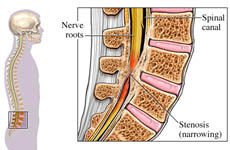 In osteoarthritis of the spine, also known as degenerative arthritis, the protective cartilage that protects the tops of your bones wears out because of daily wear and tear, aging, injury or misuse. As a result, your vertebrae start to rub together or press on a nearby spinal nerve. This can result in significant amounts of local pain and swelling.
In osteoarthritis of the spine, also known as degenerative arthritis, the protective cartilage that protects the tops of your bones wears out because of daily wear and tear, aging, injury or misuse. As a result, your vertebrae start to rub together or press on a nearby spinal nerve. This can result in significant amounts of local pain and swelling.
If the condition gets worse, movement and flexibility in your neck and back may be affected. You may feel a weakness or numbness in your legs or arms. Other symptoms include intermittent back pain, a stiff back in the morning and after activity that gets better after rest, pain and tenderness in your neck, lower back pain that runs down into your lower extremities, and difficulty bending, walking, or stretching.
If you suffer from spinal osteoarthritis, there are a few things you can do to manage your injury and lessen your pain. It is very helpful to become aware of your posture, which should be as neutral as possible at all times. If your exercise routines make your arthritis pain worse, you may need to adjust the intensity and duration of your workouts with the help of a certified physiotherapist.
Osteoarthritis of the spine can be treated with an over-the-counter or prescription painkiller, although lengthy treatment with these drugs is never advisable and we recommend natural anti-inflammatory supplements such as Heal-n-Soothe. Keeping yourself properly hydrated by drinking sufficient amounts of water every day helps your body deal better with inflammation as well.
Treatment with massage, acupuncture, and trigger-point therapy under the guidance of a physician or certified physiotherapist are all proven ways to treat osteoarthritis of the spine. Rest, relaxation, and sleep are also very effective, because your body repairs itself best during deep sleep. However, overly long periods of bed rest, splints, bracing, or traction are not a good idea as they tend to weaken your back muscles, making it harder for you to recover.
If symptoms of osteoarthritis of the spine persist or get worse and begin to interfere with your daily activities, it may be a good idea to visit your primary healthcare provider and have a complete check-up done. Treatment is usually directed towards relieving pain and improving spinal function and flexibility.
If you are overweight or obese, the first step in treating spinal arthritis may include losing weight and learning how to maintain a healthy weight by carefully monitoring your diet and managing your exercise levels. A light schedule of exercise such as swimming, walking, and water aerobics can improve your fitness, flexibility and mood along with boosting circulation, which removes inflammation waste products from your body more efficiently.
Strengthening exercises make the muscles that support your joints stronger, while aerobic exercises make your heart stronger and improve your blood flow. Finally, range-of-motion exercises are designed to increase your flexibility and make your joints more supple.
In conclusion, there are many ways you can treat osteoarthritis of the spine, both on your own and in consultation with a physician. You may need to test a few before you settle on a combination of treatments that works best to relieve your condition and allows you to lead a healthy, active life.
To learn more about osteoarthritis of the spine, please visit: Arthritis of the Spine


Which type of exercise is recommended? Does yoga help?
Richard, we have written a book on the topic of exercises we suggest for people with any type of back pain. You can get your copy right here:
https://losethebackpain.com/products/7-day-back-pain-cure-book
Thanks
steve